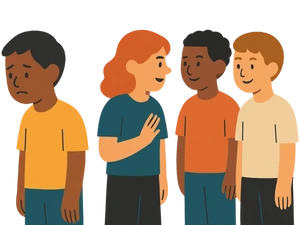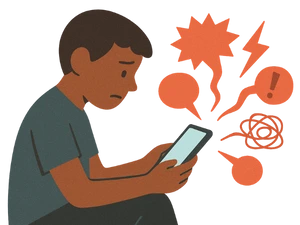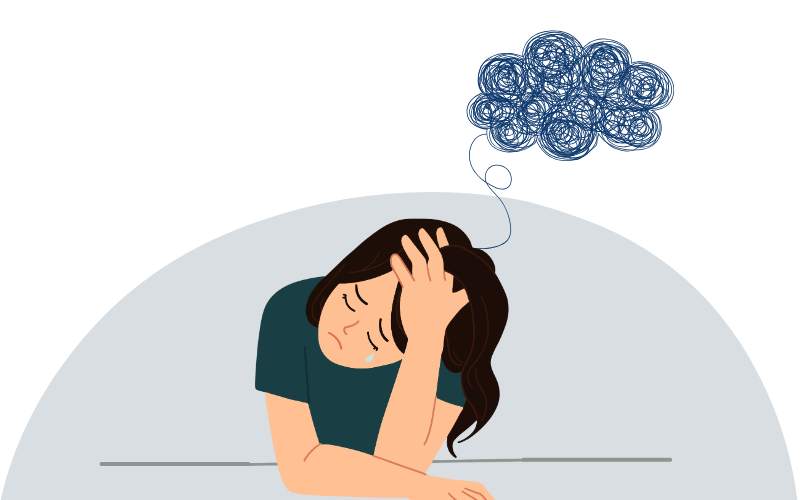Children can abuse other children — and this reality must never be ignored or minimised as “banter” or “a rite of passage.”
Child-on-child abuse (also known as peer-on-peer abuse) is a serious safeguarding issue that can cause long-term harm to victims and also impact those who perpetrate it.
The Department for Education, through Keeping Children Safe in Education (KCSiE), defines it as:
“Inappropriate behaviours between children and young people (including those within intimate personal relationships) that are abusive in nature and can take many forms, both online and offline.”
For learners on MITSKILLS, understanding child-on-child abuse is crucial. Whether you work in education, early years, or care, recognising the signs and knowing how to act can make the difference between ongoing harm and effective protection.

What Is Child-on-Child Abuse?
Child-on-child abuse encompasses a wide range of harmful behaviours. These may happen in schools, colleges, online spaces, friendship groups, or within intimate teenage relationships.
Common forms of child-on-child abuse include:
Physical abuse
Hitting, kicking, biting, hair-pulling, or other physical harm.
Sexual violence or harassment
Sexual comments, jokes, physical contact, online harassment, or sexual assault.
Sexual exploitation
Manipulation or coercion into sexual activity in exchange for money, gifts, or status.
Coercive control
Controlling another child’s behaviour, appearance, or social contact.
Bullying
Including homophobic, sexist, racist, transphobic, or disablist bullying, both in-person and online.
Sharing of nude or semi-nude images (“sexting”).
Upskirting
Taking images under clothing without consent.
Gang involvement and initiation/hazing rituals.
Teenage relationship abuse
Violence or coercion in young relationships.
Child-on-child abuse can be a single incident or a pattern of behaviour over time. Every case must be taken seriously — no matter the ages or genders involved.
Power Dynamics: The Root of Abuse
At the core of child-on-child abuse is an imbalance of power.
This imbalance can come from:
- Age, size, or physical strength.
- Social status, popularity, or influence.
- Gender or sexual identity.
- Race or culture.
- Disabilities or learning differences.
- Group dynamics, such as gangs or peer pressure.
Sometimes the power difference is obvious — one child gives orders, the other complies out of fear. Other times, it is subtle — the victim may believe they have to agree because of love, friendship, or belonging.
Example: Group Power
Within gangs or peer groups, abuse may be used to maintain status or control. Young people wanting to belong may be coerced into harmful acts, from sexual violence to criminal behaviour, as a form of “initiation.”
Recognising power imbalance helps professionals understand why “consent” is often not real consent at all.
Sexual Violence and Sexual Harassment
Sexual violence and harassment between children are among the most common and serious forms of abuse.
They include behaviours that are often wrongly minimised as “just jokes” or “part of growing up.”
Examples include:
Rape and assault by penetration.
Sexual assault — any unwanted sexual touching without consent.
Coercing someone to engage in sexual activity without consent.
Unwanted sexual comments, name-calling, or messages.
Deliberately brushing against or interfering with clothing.
Displaying sexual pictures or drawings.
Non-consensual sharing of nude or semi-nude images or videos.
“Upskirting” or similar invasive recording.
“Hazing” or initiation rituals involving humiliation or sexual acts.
The absence of consent defines sexual violence and harassment.
Even a single act — such as unwanted touching or sexualised “jokes” — can cause lasting trauma.
Who Is Most at Risk?
Any child can experience or perpetrate abuse, but research shows certain groups are at higher risk.
Vulnerable groups include:
-
- Children aged 10 years and older.
- Girls and young women — more often victims.
- Boys and young men — more often perpetrators, but also victims (especially in gang settings).
- Black and minority ethnic children — often under-identified as victims and over-identified as perpetrators.
- Children with additional needs (SEND).
- Looked-after children.
- Children in residential or boarding settings.
- LGBTQ+ children, or those perceived to be.
- Children with bereavement or abuse history.
- Children who have previously abused others — they may also be victims of earlier trauma.
Recognising vulnerability helps ensure no group is overlooked.
The Impact of Child-on-Child Abuse
The effects can be devastating — physically, emotionally, and socially.
Victims may experience:
- Fear, anxiety, and depression.
- Withdrawal from education or friendships.
- Physical injuries.
- Low self-esteem and shame.
- Self-harm or suicidal thoughts.
- Substance misuse.
Perpetrators may also need safeguarding support. Many have experienced trauma, neglect, or abuse themselves. Addressing their needs is key to breaking cycles of harm.
Research by Hackett et al. (2013) found that two-thirds of children showing harmful sexual behaviour had experienced abuse or severe neglect themselves.
Recognising the Signs
Professionals must be alert to early indicators — child-on-child abuse is often hidden.
Warning signs may include:
- Absence from school or disengagement from learning.
- Physical injuries or bruising.
- Deteriorating mental health or sleep issues.
- Fatigue or persistent tiredness.
- Alcohol or substance misuse.
- Changes in behaviour or appearance.
- Withdrawal from peers or activities.
- Displaying aggression or harmful behaviour toward others.
Sometimes, information may come indirectly — through overheard comments, rumours, or third-party reports. Always take these seriously.
Scenario: Sara’s Story
Sara, 16, is completing training after her GCSEs. Recently, she’s withdrawn from friends, changed her style, and appears anxious. Her friend Jess reveals that nude photos of Sara have been shared online — showing visible bruises — and believes Sara’s girlfriend Rachel may be involved.
This is child-on-child abuse.
It may include sexual exploitation, coercion, and domestic abuse.
Safeguarding response (based on DSL guidance):
- Report immediately to the DSL – this is a safeguarding concern.
- Do not view or share images. Retain devices only under DSL advice or police request.
- Record and gather information — sensitively speak to Jess and Sara for detail.
- Refer to Children’s Social Care and Police — with Sara’s consent if possible, or without if necessary for her safety.
- Assess risk to others, including whether Rachel needs support or intervention.
- Support Sara — help remove images, offer emotional and practical support.
- Reflect and review training — ensure all staff are confident responding to such situations.

Contextual Safeguarding
A child’s experiences don’t stop at the school gate.
They are shaped by their home life, neighbourhood, friendships, and online world.
This is known as contextual safeguarding — understanding that abuse can occur in multiple contexts and that these environments influence each other.
For example, online spaces like Snapchat may normalise violence or sexual behaviour. The Anti-Social Media Report (2023) found that some vulnerable young people live in “hyper-local bubbles” where illegal or harmful content feels “normal”.
Professionals must therefore consider not just what happens in the setting, but what influences children outside it.
Creating a Safe Culture
Safeguarding against child-on-child abuse starts with proactivity and culture.
Every setting should:
- Be proactive, not reactive.
- Create an open culture where children feel safe to talk.
- Challenge inappropriate behaviour every time — even when it seems “minor.”
- Educate about safe, respectful relationships in the curriculum.
- Model appropriate behaviour as staff and adults.
- Take disclosures seriously — never dismiss them.
- Avoid labels like “banter” or “just growing up.”
As one BBC survivor said:
“My abusers were the most popular boys in school… The principal put it down to ‘locker room banter.’”
Zero tolerance does not mean punishment — it means care, consistency, and accountability. It’s about ensuring that when we ask, “Who feels safe here?”, the answer is:
“We all do.”
What To Do If You Suspect Child-on-Child Abuse
If you believe a child may be experiencing or perpetrating abuse:
- Listen carefully and stay calm.
- Reassure the child — they have done the right thing by speaking.
- Do not promise confidentiality.
- Record exactly what is said, using the child’s words.
- Report to the Designated Safeguarding Lead (DSL) immediately.
- Avoid investigating yourself — pass information on promptly.
- Support both victim and alleged perpetrator, as both may be at risk.
For urgent help, the NSPCC “Report Abuse in Education” Helpline is available to children, parents, and professionals:
📞 0800 136 663
📧 help@nspcc.org.uk
Conclusion
Child-on-child abuse can take many forms — physical, sexual, emotional, or coercive — but it always involves harm and power imbalance.
Our role as educators, carers, and professionals is to notice, challenge, and act.
We must:
-
- Never dismiss harmful behaviour as “banter.”
- Build cultures of openness and respect.
- Support both victims and those who harm, recognising trauma on both sides.
- Keep learning and reflecting.
Every child deserves to feel safe — in school, online, and in their relationships.
📚 Further Resources
-
- Safeguarding Network: Child-on-Child Abuse
- NSPCC Report Abuse in Education Helpline – 0800 136 663
- Keeping Children Safe in Education (DfE, 2023)
- Anti-Social Media Report (Revealing Reality, 2023)
- Girlguiding Girls’ Attitudes Survey (2023)

